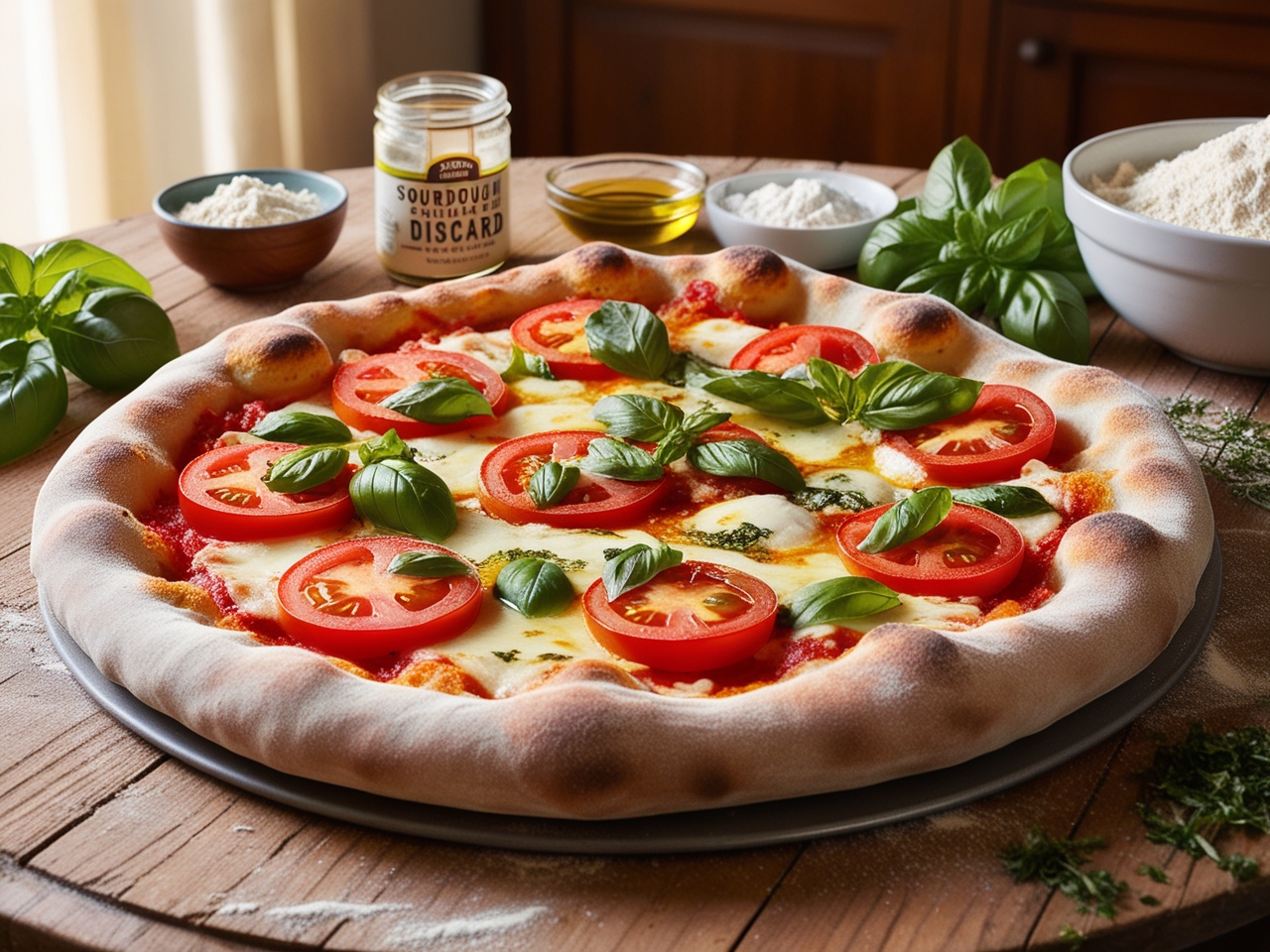Creating pizza dough with sourdough discard not only elevates your culinary game but also helps you reduce food waste while crafting a flavorful, artisanal base. This article dives into the entire process, from understanding sourdough discard to crafting, shaping, and baking the perfect pizza dough. Let’s embark on this tasty adventure and unlock the secrets of sourdough pizza-making!
Introduction to Sourdough Discard Pizza Dough
Understanding Sourdough Discard
Sourdough discard is the byproduct of maintaining an active sourdough starter, removed to ensure the starter remains healthy and balanced. While it may seem like waste, this “discard” is a treasure trove of potential. It holds a subtle tang, a hint of natural leavening, and ample flavor, making it ideal for creative recipes.
Typically, discard is more liquid than active starter, giving it unique properties that work beautifully in baked goods like pancakes, crackers, and, yes, pizza dough. Its mild acidity adds depth to the dough, resulting in a crust that’s deliciously different.
Benefits of Using Sourdough Discard in Pizza Dough
By incorporating sourdough discard into your pizza dough, you’re not just being resourceful—you’re enhancing the final product in surprising ways.
- Enhanced Flavor: The tangy essence of sourdough discard imparts a nuanced, almost rustic taste to the crust, elevating even the simplest toppings.
- Reducing Waste: Using discard means making the most of your sourdough starter without throwing anything away. It’s sustainable baking at its finest!
- Nutritional Perks: Sourdough discard contains prebiotics and residual nutrients from fermentation, which can be easier on digestion compared to standard doughs.
Whether you’re a seasoned baker or just venturing into the world of sourdough, this technique allows you to experience the magic of artisan pizza while being kind to the planet.
In the next part, we’ll explore how to prepare sourdough discard for crafting a stellar pizza dough!
Preparing Sourdough Discard for Pizza Dough
Collecting and Storing Sourdough Discard
Ensuring that your sourdough discard is ready for pizza dough starts with proper collection and storage. Every time you feed your sourdough starter, you’ll end up with discard—typically, the portion of the starter removed before feeding. Don’t throw it away! Instead, scrape the discard into a clean jar or container.

For best results:
- Collect Immediately: After discarding from your starter, transfer it to a dedicated jar to maintain its quality.
- Use an Airtight Container: Store the discard in a sealed jar or container to prevent it from drying out or absorbing odors.
- Refrigerate for Longevity: If you’re not using it immediately, refrigerate the discard. It can last up to 1-2 weeks, but fresher is always better for baking.
Avoid contamination by using clean utensils when handling the discard. Even though it’s technically “waste,” its freshness matters for crafting premium pizza dough!
Evaluating the Freshness of Sourdough Discard
A crucial step is checking if your sourdough discard is suitable for use. While discard can develop a tangy aroma over time, spoilage is entirely different.
- Indicators of Spoilage: If your discard shows signs of mold, a slimy texture, or a strong, unpleasant smell, it’s time to toss it. A slightly sour smell is normal and desirable.
- Optimal Age: The best discard is between 1-5 days old, stored in the fridge. Older discard may still work but could contribute excessive sourness or compromise dough structure.
Knowing how to manage your sourdough discard ensures that your pizza dough turns out flavorful and safe to eat!
Crafting the Perfect Sourdough Discard Pizza Dough
Essential Ingredients and Their Roles
Crafting the ultimate pizza dough starts with understanding each ingredient’s role. Each component works together to create a balanced, delicious crust.
- Sourdough Discard: It’s the star of the show, adding a tangy depth and subtle complexity to your pizza dough. It also provides a touch of natural leavening, making your crust tender yet chewy.
- Flour Choices: For most recipes, all-purpose flour works perfectly, delivering a light, tender crust. For a chewier, more robust texture, try bread flour, which has a higher protein content.
- Hydration Levels: Balancing the water content is essential for dough elasticity and ease of shaping. A medium hydration dough (60-70%) works well for beginners.
- Salt: This unsung hero enhances the overall flavor and strengthens the gluten network for better dough structure.
- Optional Additions: Ingredients like olive oil, dried herbs, or garlic powder can add an extra burst of flavor to the dough.
Having the right ingredients in the correct proportions sets the foundation for your pizza masterpiece.
Step-by-Step Dough Preparation
Let’s dive into the process of creating sourdough discard pizza dough from scratch:
- Mixing Ingredients: Combine your sourdough discard with flour, water, salt, and optional flavorings in a large bowl. Mix until it forms a shaggy, slightly sticky dough.
- Kneading Techniques: Knead by hand for 8-10 minutes or use a stand mixer with a dough hook until the dough becomes smooth and elastic. This step develops gluten, crucial for structure and chewiness.
- Bulk Fermentation: Place the dough in a lightly oiled bowl, cover it, and let it rise at room temperature for 3-4 hours. This period allows the flavors to develop and the dough to expand.
- Dividing and Pre-Shaping: Once the bulk fermentation is complete, divide the dough into portions. Pre-shape each portion into a ball by folding the edges into the center and rolling it on a floured surface.
- Final Proofing: Let the dough rest at room temperature for 1-2 hours or refrigerate overnight for enhanced flavor. Cover with plastic wrap or a damp cloth to prevent drying.
Patience is key during each stage, as it directly influences the final texture and taste of your pizza crust.
Adjusting Fermentation Timeframes
Your lifestyle and schedule may dictate how long you can dedicate to fermentation, and that’s okay!
- Same-Day Strategies: If you’re short on time, allow the dough to rise in a warm spot (around 75-80°F). This accelerates fermentation, making the dough ready in 4-5 hours.
- Overnight Benefits: For enhanced flavor, refrigerate the dough overnight after kneading. Slow fermentation allows complex flavors to develop while improving dough texture.
- Refrigeration for Extended Fermentation: If you want to prepare ahead, keep the dough refrigerated for up to 48 hours. This method maximizes flavor complexity without over-proofing.
Flexibility in fermentation ensures you can enjoy pizza on your schedule without sacrificing quality!
Next, we’ll shape, top, and bake your sourdough discard pizza for that perfect crust every time!
Shaping and Baking Your Pizza
Techniques for Shaping the Pizza Base
Shaping the pizza base is a crucial step in achieving that perfect crust. The method you choose impacts both texture and presentation, so let’s get rolling—or stretching!
- Hand-Stretching vs. Rolling Pin: Hand-stretching is the traditional method that retains air bubbles in the dough, leading to a softer, airier crust. On the other hand, a rolling pin provides a uniform thickness but can compress the dough, resulting in a denser texture. Choose based on your desired outcome.
- Achieving Desired Thickness and Size: For a thin crust, stretch the dough outward with your hands, rotating it to keep the shape even. If you prefer a thicker base, avoid over-stretching and focus on keeping the edges thicker for a defined crust.
- Creating a Uniform Crust: To ensure the dough doesn’t tear, use your fingertips to gently press from the center outward. Aim for a smooth, even base with slightly thicker edges to hold toppings. A light dusting of flour on the work surface prevents sticking.
A little practice makes perfect, so don’t worry if your first few attempts are a bit irregular—rustic shapes are part of the charm!
Selecting and Applying Toppings
Toppings transform your sourdough discard pizza dough into a culinary masterpiece. While the crust provides the foundation, the right combination of flavors takes it to the next level.
- Traditional Toppings: Classics like marinara sauce, mozzarella cheese, and pepperoni deliver timeless appeal. Vegetables like mushrooms, onions, and bell peppers add texture and freshness.
- Creative and Seasonal Ideas: Experiment with unique ingredients like roasted garlic, caramelized onions, or artichoke hearts. Seasonal toppings—like asparagus in spring or squash in fall—keep your pizza exciting and flavorful.
- Balancing Flavors and Textures: Pair salty items (like olives) with sweet accents (like honey drizzle). Add crunchy elements like arugula after baking for contrast. Don’t overload the pizza; too many toppings can overwhelm the crust and lead to sogginess.
Pro tip: Apply toppings evenly, leaving a small border around the edges to let the crust shine.
Baking Methods and Tips
The final baking step is where the magic happens. The right technique ensures your pizza has a golden crust, melted toppings, and the perfect bite.

- Oven Settings: Preheat your oven to the highest temperature it can handle—typically around 475-500°F (245-260°C). Place the rack in the middle or lower third for even baking.
- Using Pizza Stones or Baking Sheets: A preheated pizza stone mimics the heat of a traditional wood-fired oven, creating a crispy base. If you don’t have a stone, a heavy-duty baking sheet works well, especially if preheated.
- Monitoring Bake Time: Keep an eye on your pizza as it bakes, typically 8-12 minutes depending on thickness. Look for a bubbly, golden crust and evenly melted cheese. Rotate the pizza halfway through for even cooking.
- Post-Baking Considerations: Let the pizza rest for a couple of minutes after baking to allow the crust to set and the toppings to cool slightly. Slice with a sharp knife or pizza cutter for clean, crisp portions.
Perfecting your baking technique ensures your sourdough discard pizza dough reaches its full potential—crispy, chewy, and utterly delicious!
Enhancing Your Sourdough Discard Pizza Experience
Flavor Variations in the Dough
Why settle for plain dough when you can infuse it with exciting flavors? Elevate your crust with a few creative tweaks.
- Incorporating Herbs and Spices: Add dried oregano, thyme, or rosemary to the dough for an aromatic twist. Crushed red pepper or garlic powder adds a gentle kick.
- Using Infused Oils: Swap plain olive oil for infused versions—think roasted garlic, chili, or basil oil—to subtly enhance the flavor of the crust.
- Adding Whole Grains or Alternative Flours: Mix whole wheat flour with all-purpose flour for a nuttier, more rustic taste. Experiment with spelt, rye, or even a touch of cornmeal for texture variety.
These variations allow you to customize your pizza crust to match your taste preferences.
Pairing Pizzas with Sides and Beverages
A great pizza deserves equally impressive accompaniments. Consider these options to round out your meal:
- Complementary Salads and Appetizers: A fresh, crisp salad—like arugula with lemon vinaigrette—offers a light contrast to the hearty pizza. Appetizers such as garlic bread or bruschetta keep the Italian theme going.
- Non-Alcoholic Pairings: Sparkling water with a twist of lemon or a refreshing iced herbal tea makes for excellent beverage choices, complementing the pizza’s flavors without overpowering them.
Pairing thoughtfully elevates the dining experience, making it more enjoyable and cohesive.
Storing and Reheating Leftover Pizza
Leftovers? Lucky you! Proper storage and reheating techniques ensure your pizza tastes as good the next day.
- Storage Tips: Place slices in an airtight container, layering parchment paper between them to prevent sticking. Refrigerate for up to three days or freeze for longer storage.
- Reheating Methods: For the best results, reheat slices in a skillet over medium heat with a lid. This method crisps the bottom while warming the toppings. Alternatively, use an oven at 375°F (190°C) for about 8-10 minutes.
These tips keep your sourdough pizza tasting fresh and delicious, even as leftovers!
Next, we’ll dive into frequently asked questions about sourdough discard pizza dough, ensuring no stone is left unturned in your pizza-making journey!
Frequently Asked Questions (FAQs)
What is sourdough discard, and how is it different from active starter?
Sourdough discard is the portion of sourdough starter removed before feeding it with fresh flour and water. It’s typically removed to maintain the proper balance of yeast and bacteria in the starter, preventing overgrowth. While discard contains the same beneficial microbes as an active starter, it’s not as bubbly or potent in leavening power.
Active starter, on the other hand, is fully fed, vibrant, and ready to leaven bread. Discard is best used in recipes where the natural tang and slight rise it provides are enough, like in pizza dough or pancakes.
Can I use sourdough discard directly from the refrigerator?
Yes, you can use sourdough discard directly from the refrigerator! Cold discard often works well for recipes like pizza dough because it doesn’t require the same leavening power as bread. However, if the discard has been sitting for a while, allow it to come to room temperature to make it easier to mix into your dough.
Using cold discard may slightly affect fermentation time, but it’s usually negligible. Just ensure the discard is fresh and free of signs of spoilage before using it.
How does sourdough discard affect the flavor of pizza dough?
Sourdough discard introduces a unique tanginess to the dough, setting it apart from conventional pizza crusts. The discard’s natural acidity imparts a subtle sour flavor that complements a wide range of toppings.
Additionally, the fermentation process softens the dough, resulting in a more tender texture. While the tanginess is mild, it adds depth and character to the crust, enhancing its overall flavor profile.
Is it necessary to add commercial yeast to sourdough discard pizza dough?
Adding commercial yeast is optional, but it can be beneficial depending on your desired results.
- Without Yeast: If you’re relying solely on sourdough discard, expect a longer fermentation time as the natural yeasts in the discard work more slowly. This method results in a more pronounced sour flavor.
- With Yeast: Adding a small amount of instant yeast ensures a quicker rise and more consistent results, especially for same-day pizza dough.
Either method works, but the decision depends on your time constraints and flavor preferences.
Can I freeze sourdough discard pizza dough for later use?
Absolutely! Freezing sourdough discard pizza dough is a convenient way to enjoy homemade pizza anytime.
- To Freeze: After kneading and allowing the dough to rise, divide it into portions and shape them into balls. Wrap each portion tightly in plastic wrap and place them in a freezer-safe bag.
- To Use: Defrost the dough in the refrigerator overnight, then bring it to room temperature before shaping and baking.
Freezing does not compromise the flavor or texture of the dough, making it a great option for meal prep.
What are some common mistakes to avoid when making sourdough discard pizza dough?
Mistakes are part of learning, but avoiding these common pitfalls can ensure your pizza dough turns out perfectly:
- Overproofing: Allowing the dough to ferment for too long can lead to a weak structure, causing it to collapse during baking.
- Underhydrating: Sourdough discard dough benefits from a slightly higher hydration level. Too little water can make the dough tough and difficult to work with.
- Skipping the Rest Period: Always let the dough rest after kneading and shaping. This relaxes the gluten and makes the dough easier to handle.
- Overloading Toppings: Adding too many toppings can weigh down the crust and prevent it from cooking evenly.
With attention to detail and practice, these mistakes can be easily avoided, making your pizza-making journey more enjoyable!
Conclusion
Embracing the Art of Sourdough Discard Pizza Making
Making pizza with sourdough discard is more than just a recipe—it’s an opportunity to experiment, reduce waste, and savor homemade creations. Each step, from mixing the dough to baking the final crust, invites you to personalize and refine the process.
The joy of transforming a humble discard into a flavorful pizza crust is unmatched. So, roll up your sleeves, embrace the art of sourdough, and let your kitchen be a canvas for culinary creativity. Enjoy every bite of your perfectly crafted pizza!
For another delicious recipe using sourdough discard, try our guide on How to Make Soft and Fluffy Sourdough Discard Cinnamon Rolls.

